



























































































































BONUS PROGRAM - COVERAGE EFFECTIVE: JULY 1, 2024 TO JANUARY 1, 2025




















Earn even more for offering your clients California’s most comprehensive access to doctors and hospitals:
Full Network PPO
• Blue Shield
HMO offerings from
• Blue Shield
•Kaiser Permanente
• Sharp Health Plan
CCSB offers 4-tier selection
Single bill
CCSB offers more Blue Shield Plans
Contact your local Covered California for Small Business sales representative to learn why we’re growing and how we can help build your business! An increasing number of agents and their clients are glad they did.
CoveredCA.com/ForSmallBusiness 844.332.8384
1. Applies to new to Covered California for Small Business (CCSB) groups with initial effective dates of 07/1/24, 08/1/24, 09/1/24, 10/1/24, 11/1/24, 12/1/24 and 1/1/25
2. Agency must submit minimum of three groups to qualify for bonus program
3. Bonuses will be calculated on number of subscribers (employees) in e ect for the first e ective month of the policy as determined by CCSB.
4. No pro-ration of target values will take place.
5. Business written through partnering General Agencies qualifies.
6. Covered California will issue the second bonus (6+ groups) incentive payment forty-five (45) days following the conclusion of the incentive program so long as qualifying groups satisfy the ninety (90) day requirement outlined in Section (E)(2)(c) of Exhibit F of the Agency Agreement.
For a complete list of the program rules go to: https://www.coveredca.com/pdfs/Exhibit_F_Commission_Schedule_March_2024_Final.pdf

In a dynamic healthcare landscape, the right partner makes all the difference.
At Pinnacle Claims Management, Inc. (PCMI), we don’t just offer insurance—we deliver comprehensive healthcare solutions. Tailored programs. Insightful analytics. Flexible pricing. All designed with your client’s unique needs in mind.
Join forces with PCMI. Together, we can create unparalleled healthcare experiences for your clients, enhancing their well-being and expanding your business horizons.
Discover PCMI Excellence. Scan here.
pinnacletpa.com/excellence



August 20 to 22, 2024 at Pechanga Resort Casino, Temecula, CA
e BEST lineup of speakers are scheduled to educate you about growing your medicare business
Stan Morrison will be our Keynote Speaker on August 21, is a renowed basketball coach who has a lot of business savvy to explain how to use the rules of sports in devloping your business to gain more medicare clients.
On August 20, another powerful Keynote Speaker, Michael Fahey III, former Marine who is now the district manager for Colonial Life. His inside knowledge of the industry will enlighten you. Michael will teach you the tricks he has learned to be a successful agent.
is will be a very informative summit. e CEO of NABIP, Jessica Brooks-Woods and the incoming president of CAHIP, Rosamaria Marrujo, will share what some of the new rules will be in a panel discussion for medicare for 2025.
Register today for this important Medicare Summit! A full 3 days of educational certi cations and CE classes, informative panel discussions plus several other guest speakers who are sure to give you all the tools you will need to be a successful Medicare agent. Plus breakout sessions and exhibitors including various insurance carriers, medical groups, and supplemental bene t providers all ready to share their information.


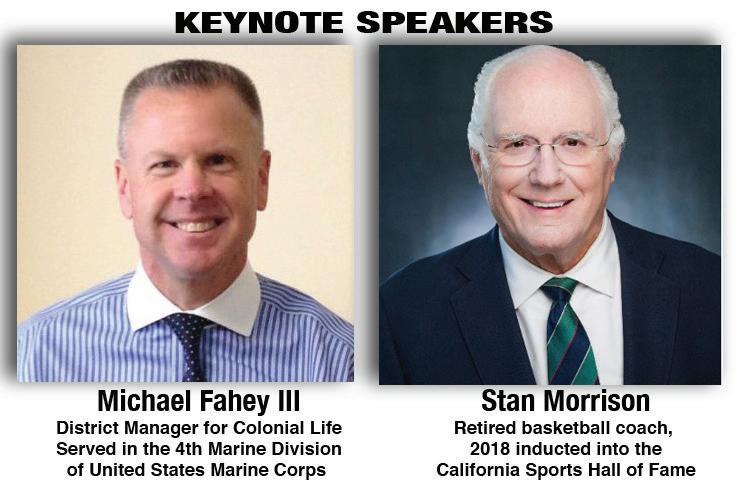
Breakout Sessions, Training Programs, and discussions about the new Medicare Legislation both state and federal for 2025
Visit our website: theseniorsummit.net




14
CALIFORNIA POSITIVE
Cal Broker’s commitment is to be the leading source of news and information for California brokers and agents operating in the health, life, and annuity industry. We are committed to connecting Life and Health insurance professionals to valuable resources and solutions they can provide to their insurance clients.
Work and Play Stories and Tips
California truly offers a lifestyle that combines career fulfillment with an unparalleled quality of life. In this series, we will highlight some of the opportunities for work, and play that California offers
By Emma Peters
16
HEALTH
When to Go to Urgent Care vs. The Emergency Room
Knowing which illnesses and injuries require urgent or emergency care can be challenging. So, how do you know where to go? Understanding the differences can help you advise your clients on how to get the right care and reinforce your trusted advisor’s value with clients.
By CalBroker

18
HEALTH & WELLNESS
Healing Through Prayer: Limits of Science on Medical Therapy Can prayer be the answer to both curing disease and supporting medical professionals or other healthcare workers? Learn from this article which discusses the limits of traditional healthcare methods and dives into the medical benefits of a deep faith and consistent prayer life.
By Joan Donnellan
20
HEALTH & WELLNESS
Help Boost Employee Wellness & Productivity with Benefits of New Transitions® GEN S Lens
One easy and effective way to create workplaces where employees can truly thrive is by offering comprehensive vision benefits that include premium lens options. With healthier eyes, employees can experience increased productivity and overall wellness no matter where they work. As such, employees deserve the best vision care benefits an employer can offer, and light management is key.
By Jonathan Ormsby
FTC Rule Banning Non-Competes: Could This Be the End?
In April, the FTC issued a final rule largely banning non-competes nationwide. The groundbreaking ruling has the potential to shake up the job market. With millions potentially affected, what’s at stake for employers and employees? Dive in to explore alternatives and unravel potential impacts. Will this ruling revolutionize the workplace or spark a legal battleground?
By Misty Baker
24
COMMISSION SOLUTIONS
From One Subject Matter Expert to Another
Cal Broker salutes health insurance experts as they play a crucial role in helping their clients navigate the complex landscape of health insurance policies, coverage options, accessing care, and managing healthcare costs. For new brokers in this industry the information below includes “items” to strive to perform.
By Phil Calhoun & David Ethington
Create a Combination of Differentiators to Win New Clients
Learn about the value of creating a combination of differentiators to distinguish yourself and stay relevant to your prospect. This author provides 5 common attributes which DON’T make you different and 14 specializations that DO make you different.
By Bill Cates
28 LTCi
Collaborating with a LTCi Expert Solves Client Risks
We asked Renée Caldwell to share with us how she collaborates with clients and referrals from health insurance professionals who have clients that have a need to review their options for LTC insurance or look at an in-force policy.
By Renée Caldwell
30
The Riches Really are in the Niches…. For The Right Advisors
The old saying “the riches are in the niches” has never been truer when it comes to proper advisement in the employee benefits space. One industry that we can focus on is the government contracting community. Dive into the special focus and attention that this type of group needs.
By Eric Trost
32 MEDICARE
The Senior Summit: Mastering Medicare Challenges
Senior Summit is almost here! Get ready to learn about all the changes coming in Medicare sales and marketing and more!
By Maggie Stedt, C.S.A, LPRT, Medicare Chair
In recent years, the California Society of Certified Public Accountants (CalCPA) has expanded to include a broader swatch of firms, including financial professionals. Learn about financial services firms and how they provide good opportunities for health insurance brokers because all their existing (business) customers have CPA and financial service firms they can easily prospect to.
By Genna Armanini
34
New Book Written by Former California Broker VP Scott Halversen
Read about Scott Halverson’s new book which chronicles his journey with a cancer diagnosis. Heartfelt and deeply personal, Halversen decided to share his cancer treatment story in the hope of connecting with readers facing their own cancer diagnosis to help them understand they are not alone in their fight.
By CalBroker Mag

PUBLISHER Phil Calhoun
Health Broker Publishing, LLC publisher@calbrokermag.com
PRODUCTION DIRECTOR Zulma Mazariegos zulma@calbrokermag.com
DIGITAL DIRECTOR Carmen Ponce carmen@calbrokermag.com
EDITOR ASSISTANT Emma Peters emma@calbrokermag.com
CIRCULATION
zulma@calbrokermag.com
120,000 subscribers
12,000 monthly website visits
ADVERTISING
Health Broker Publishing 14771 Plaza Drive Suite C Tustin, CA 92780 714-664-0311 publisher@calbrokermag.com
publisher@calbrokermag.com
Subscriptions: U.S. one year: $24. Send change of address notification at least 20 days prior to effective date; include old/new address to:
Health Broker Publishing 14771 Plaza Drive Suite C • Tustin, CA 92780 714-664-0311
California Broker (ISSN #0883-6159) is published monthly. Periodicals Postage Rates Paid at Burbank, CA and additional entry offices (USPS #744-450).
POSTMASTER: Send address changes to California Broker, 14771 Plaza Drive Suite C • Tustin, CA 92780
©2024 by Health Broker Publishing. All rights reserved. No part of this publication should be reproduced without consent of the publisher.
No responsibility will be assumed for unsolicited editorial contributions. Manuscripts or other material to be returned should be accompanied by a self-addressed stamped envelope adequate to return the material. The publishers of this magazine do not assume responsibility for statements made by their advertisers or contributors.
worry about future of Medicare, Social Security, Gallup poll
Availability of programs likely influences older adults’ voting decisions, respondents say
Adults in the U.S. are more worried than ever about whether Medicare and Social Security benefits will be available when they need them.
In response to a Gallup poll released in June, 75% of adults age 65 and younger said they are “worried” or “extremely worried” about lack of Medicare availability, according to a press release.
When it comes to Social Security benefits, 80% of survey respondents said the same. Both of those percentages have increased since the last poll in 2022.
The data came from the West HealthGallup 2024 Survey on Aging in America, which polled 5,149 adults 18 and older between November 2023 and January 2024.
The older the respondents, the more likely they were to consider Social Security and Medicare important — 87% of adults 65 or older said they were the “highest priority” programs, twice as many compared to those between 18 and 29 years of age, according to the results.
The poll also found that more than half of Americans are “somewhat more likely” or “much more likely” to make voting decisions based on their support of programs that affect older adults — and among adults 65 and older, that figure rises to 77%.
“The overwhelming majority of people do not think the U.S. is doing enough to address the needs of its growing aging population.”
Timothy Lash, president of West Health, a California nonprofit focused on health care and aging that partnered with Gallup to conduct the poll, said the findings showed the “magnitude of concern” people have about aging.
“High and rising concerns over the future viability of Medicare and Social Security and the high cost of health care dominate people’s thinking on aging,” Lash told Fox News Digital via email.
“The ove rwhelming majority of people do not think the U.S. is doing enough to address the needs of its growing aging population.”
By 2034, the U.S. Census Bureau estmates that adults 65 and older will outnumber children under 18 for the first time, he noted.
By Melissa Rudy

Those who are concerned should communicate with their policymakers and elected officials, Lash advised.
“A whopping two-thirds of Americans feel the country is not prepared to address the overall needs of its rapidly growing older population, and these concerns may influence who they vote for in upcoming elections,” he said.
Among increasing concerns over health care affordability and the future of Medicare and Social Security, Lash said, “Americans need to look at who is going to rein in the high cost of health care and protect and strengthen safety net programs for future seniors.”
As the aging population continues to grow, Lash emphasized the importance of addressing their needs and challenges.
“It’s up to all of us to work to reduce the concerns over aging and raise the promise and hope of growing older in America,” he added.
Whitney Stidom, vice president of Medicare Operations at eHealth in Salt Lake City, said she was not surprised by the Gallup poll’s findings.
“As we enter the last few months of the election [season], candidates from both parties should be clear that it’s not only seniors who care about the future of Medicare — younger people care, too,” Stidom told Fox News Digital via email.
“It’s up to all of us to work to reduce the concerns over aging and raise the promise and hope of growing older in America.”
In a March survey by eHealth, 78% of millennials and Gen Xers identified Medicare as a “top-three” voting issue, and 84% said they were willing to contribute more in payroll taxes to ensure its future, according to Stidom.
“We are anticipating unprecedented volatility in the Medicare Advantage marketplace due to continued financial pressures within the entire health care industry, regulatory changes, and the inevitable sticker shock that consumers will see when their plan notices of change arrive in the mail come September’s annual enrollment period,” she said.
To help avoid cost increases or loss of certain benefits in 2025, Stidom encourages seniors to review their Plan Notice of Change letters carefully as soon as they arrive — and to go over their options with a trusted, licensed adviser.
“Don’t wait until the last minute to make selections for next year,” she added.
When contacted by Fox News Digital, a spokesperson for the Centers for Medicare & Medicaid Services (CMS) provided the following statement.
“Medicare provides a crucial lifeline for over 65 million Americans who depend on this vital program for their health care needs. The Biden-Harris Administration has taken many actions to strengthen Medicare while improving its sustainability and has proposed enhancements that would extend its solvency while strengthening benefits. CMS is committed to protecting Medicare now and for future generations.”
Dear Valued Broker,
We are writing to inform you of an important change affecting Blue Shield of California members. Effective June 29, 2024, the contract between Blue Shield of California and Stanford Health Care hospitals and facilities has ended.
Key Details:
Effective Date: June 29, 2024
Facilities Affected:
• Stanford Health Care Medical Center
• Lucile Packard Children’s Hospital
• Stanford Health Care Tri-Valley
Despite many months of good faith negotiations, Blue Shield and Stanford Health Care were unable to reach a new agreement on reimbursement rates and contractual terms. As a result, these facilities are no longer in-network for Blue Shield members in Santa Clara and Alameda counties.
Notification: Impacted HMO and PPO members, including Individual and Family Plan, Small Business, and Large Group members, who have received care in the last 12 months or live within a 15-mile radius of a Stanford Health facility, will be notified by July 3, 2024.
Alternate Facilities: Members will continue to have access to quality medical care through Blue Shield’s extensive hospital network. Nearby alternate facilities include:
• El Camino Health
• Good Samaritan Hospital
• Mills-Peninsula Medical Center
• O’Connor Hospital
• Regional Medical Center of San Jose (No pediatric/NICU services)
• Santa Clara Valley Medical Center
• UCSF Medical Center and UCSF Benioff Children’s Hospital –Oakland (37 miles from Lucile Packard Children’s Hospital)
Find a Doctor Tool: Members can use the Find a Doctor tool to search for other facilities and hospitals.
Member Services: Members can call the number on their Blue Shield member ID card for assistance with transitioning care to an in-network provider.
Blue Shield is committed to ensuring that members continue to have uninterrupted access to quality medical care and will work closely with providers and members to facilitate a smooth transition.
Please contact your BenefitMall team if you have any further questions.

Dear Valued Broker, At BenefitMall, we recognize the pivotal role you play in delivering exceptional service to your clients. That's why we’re excited to announce the upcoming launch of our enhanced Client Ready Quote System® (CRQS), designed with your business in mind. We're making it easier to quote new policies and renewals.

LIMRA’s Industry Trends: The World of Work — and Workplace Benefits — Is Changing
LIMRA research reveals benefits are critical to both employees and employers
Coming out of the pandemic, the way we work has changed significantly. Today, there are five generations in the workplace, more employees are working remotely or in hybrid roles, and others are working as gig or freelance workers. As a result, employers are facing substantial competition for top talent.
These changes have influenced the workplace benefits industry. According to LIMRA research, 70% of employers say their company’s benefits package will be critical to attracting and retaining the best workers. In addition, 51% believe their company will be offering more benefits in the future than it does today and 61% of employers say their employees will expect a wider variety of benefit options.
a freelance or gig position within the next five years. Similarly, for those who supplement their traditional job with freelance work, 65% say they will look to make their freelance work

their primary source of income.
Today, many employees — especially middle-income workers, younger workers, and those who currently don’t work with a financial advisor — rely heavily on an employer to provide a comprehensive benefits package.
LIMRA research shows employers want to offer traditional and non-traditional benefits that can help workers address the financial risks they face. Yet rising medical premiums are putting a squeeze on employers’ ability to provide a broader employer-paid benefits package. As a result, more companies are offering benefits on a contributory or voluntary basis, shifting the costs to their workers.
READ FULL ARTICLE
https://bit.ly/3Yc6GQr
The study shows there is growing interest in gig work. LIMRA research shows that of the 66% of employees who currently work at a traditional job, 36% say they are likely to pursue
At the same time, more employers are looking to leverage freelance workers, and many employers are looking to provide benefits to these workers. For carriers and other benefits providers, this will have an impact on things like product design and who is eligible for benefits.
To combat nursing shortage, universities create accelerated 12-month training programs: ‘A win-win’

America needs nurses — and some schools are implementing accelerated programs to train them.
A shortage of over 78,000 registered nurses is projected for next year
By Kailey Schuyler
“I think the ability to get a second degree in something like a bachelor’s in nursing is very appealing to many people,” UNE Nursing School’s interim director Donna Hyde told Fox News.
“They don’t have to have a health care background. We will get them there.”
The new fast-track nursing program at the University of New England is slated to begin in May.
To shorten the process, these programs cut training time from up to four years down to one.
“I really do think this is a win-win for students and local hospitals and facilities,” said Elizabeth Mann, assistant clinical professor at the University of New England, in an interview with Fox News. She’s based in Maine.
Prospective students must have a previous bachelor’s degree and need to complete eight prerequisite courses.
This is dramatically shorter than the typical two- to four-year nursing program.
The goal is to help students get into the workforce sooner, but they’ll have to put in some serious training as well, experts say.
“There’s nothing cut back. They do the same amount of clinical hours, so we allow time for that,” said Hyde.
READ FULL ARTICLE
https://fxn.ws/4fefbjX
BY SUZANNE BLAKE

A new bill would see Medicare coverage change for millions of Americans by offering at-home care services.
Democratic U.S. Congressman Pat Ryan of New York proposed the Improving Access to Emergency Medical Services for Seniors Act, which would add coverage to at-home treatment for minor health issues under Medicare.
The bill calls to create a “treatment-in-place model,” which would effectively end the rule that Medicare patients must be transported to a hospital to receive program reimbursement. The bill also seeks broadened compensation for emergency responders and to lessen the burden of Medicare costs on taxpayers.
More From Newsweek Vault: Checking Account vs. Savings Account: Which is Best for Your Finances?
“Our grandparents, neighbors, and friends are safer and healthier because of the dedicated care paramedics and EMTs provide to our community,” Ryan said in a statement. “They deserve to be compensated—no matter where they administer care.”
The proposed law has at the moment only gained support from two Republicans and two Democrats.
“Emergency Medical Services providers are at the frontline of delivering care and transportation in rural America,” GOP Representative Carol Miller of West Virginia, one of the representatives who backs the bill, said in a statement.
“In West Virginia, many patients live hours from a hospital and must consistently rely on EMS for treatment. Our EMS personnel are equipped to provide care to patients that may not be in a dire medical situation, rather than spend precious time and resources on transporting non-emergency patients to a hospital emergency department.”
Several organizations, from the National Rural Health Association to the International Association of Fire Chiefs, have come out in support of the proposed Medicare change.
“The bill Representative Ryan is leading is dealing with an issue that is continually gaining traction and rightfully so,” Alex Beene, financial literacy instructor at the University of Tennessee at Martin, told Newsweek.
“Many seniors, especially those in rural areas, are encountering fewer facility options for healthcare. Hospitals and clinics in their area have seen closures and reduction of hours, and for some patients dealing with significant issues, it can be difficult to leave their home to receive care.”
If seniors—the ones who benefit from Medicare—have the treatment-in-place option, they could see lower costs and better health outcomes, experts say.
Seniors make up a substantial portion, or 20 percent, of emergency room visits.
“This proposal looks to extend Medicare services to be more inclusive of at-home care for a population that desperately needs it,”
Beene said. “The question, as always, is will other legislators see the vast benefits this could provide Medicare recipients or will they
favor on the side of more restrictions.” Medicare has undergone other changes as of late, most recently proposing coverage of digital therapy services for the first time. Doctors would be reimbursed for the subscription and app fees for digital mental health services. Depending on the case, providers could be reimbursed from $10 to $110 monthly per patient.
“Simply put, it’s time,” Beene said. “We know many seniors are more tech savvy than past generations in their age group and being able to access digital mental health services can be a real difference maker depending on their situations. This would allow for more flexibility in how and when they can access these crucial services.”

Sen. JD Vance (R-Ohio), who was tapped as former President Trump’s running mate Monday, has been in the Senate for less than two years but has staked out health care positions that both buck his party and toe the GOP line.
Vance is a Yale-educated venture capitalist but rode the wave of Trump-era populism to a Senate seat. Like most Republicans, he is strongly anti-abortion, opposes genderaffirming care and wants to exclude “Dreamer” immigrants from federal health programs.
But he’s also expressed opposition to completely repealing ObamaCare, has supported Medicare drug price negotiation, and worked across the aisle to push federal health authorities to support the people of East Palestine, Ohio, after a train derailment caused a chemical spill.
Here’s where he stands on key issues:
Vance authored a 2017 New York Times op-ed in which he criticized the House and Senate efforts to repeal the health law because each would eliminate support for lowincome individuals and leave too many people uninsured.
“We’ll rail against the way the government has destroyed our health care market in one breath and resist the support offered to the poor and middle class to navigate this brokenness with the other. This is not conservative; it is incoherence masquerading as ideological purity,” he wrote.
When Trump expressed support last year
BY NATHANIEL WEIXEL
for reviving repeal efforts, Vance was among the many Senate Republicans who shrugged it off.
When asked about Trump’s comments, Vance told Semafor at the time that while health care was too expensive and “ripe for reform,” some parts of the law were “broadly popular,” like protections for people with preexisting conditions.
“I don’t think there’s any effort to try to change them,” Vance told the outlet.
But there will likely be a major battle in Congress next year about whether to extend enhanced ObamaCare subsidies that helped people afford insurance. Congressional Republicans and outside conservative groups are largely opposed to such a move, though Trump has not weighed in.
In a 2022 interview with AARP during his Senate campaign, Vance said he supports allowing Medicare to negotiate drug prices.
“I think we have to let Medicare negotiate prescription drug prices so that our seniors aren’t paying through the roof for prescription drugs,” Vance said.
Drug price negotiation is one of the key provisions of President Biden’s Inflation Reduction Act, which Republicans oppose. Many in the GOP argue Medicare negotiations are government price controls that could hurt new drug development.
Trump originally campaigned on Medicare drug price negotiations in the run-up to the 2016 election, but later dropped it in favor of a “most favored nation” policy tying Medicare drug payments to overseas pricing.
Vance also backed letting U.S. companies import drugs from overseas, another policy Trump supported while in office.
Vance opposes using taxpayer money to provide health care for “Dreamers,” people brought to the country illegally as children but shielded from deportation under the Deferred Action for Childhood Arrivals (DACA) program.
He introduced a bill to explicitly exclude DACA recipients from ObamaCare and bar the use of any federal taxpayer dollars through Affordable Care Act waivers for providing
health insurance coverage for immigrants living in the country illegally.
Vance blasted a Biden administration policy finalized in May that would allow DACA recipients to enroll in certain ObamaCare exchange plans, saying Biden was “giving your hard-earned money away to illegal immigrants in the form of taxpayer-funded health care.”
Vance last year introduced a bill that would make providing gender-affirming care to minors a felony with a 10 to 25-year prison sentence.
The bill mirrors state bans on the procedures, but also would block taxpayer funding for it, including banning coverage of gender-affirming care from ObamaCare plans. It banned universities from providing instruction on “gender-affirming care,” and deemed noncitizens who performed any gender-related procedures on a minor ineligible to receive visas or admittance to the United States.
Vance has also cast doubt on the mental health impact of such treatment.
Vance has a strong anti-abortion record and was given an A+ ranking by Susan B. Anthony Pro-Life America, a prominent antiabortion group.
He campaigned against Ohio’s 2023 ballot measure that guaranteed the right to abortion, and previously said he’d vote for a nationwide abortion ban at 15 weeks.
During his campaign for Senate, Vance applauded the overturning of Roe v. Wade and supported Texas’s ban on abortion, which does not allow exceptions other than cases where the mother’s life is at risk.
“Two wrongs don’t make a right,” he said in 2021 when asked whether abortion laws should allow for exceptions for rape and incest.
However, the next year, Vance said during a debate, “I’ve always believed in reasonable exceptions.”
Much like Trump, Vance has been trying to show he can moderate on the issue.
But the power system operator has issued a pair of alerts to energy providers that remain in effect into the middle of this week
By ROB NIKOLEWSKI
Though there are no signs that residential utility customers need to reduce their energy use, a lingering heat wave covering much of California has prompted the state’s grid operator to send an alert to power companies.
The California Independent System Operator has issued a Restricted Maintenance Operations notification to utilities (such as San Diego Gas & Electric) and electricity transmission operators, instructing them to avoid performing routine maintenance through 11:59 p.m. Thursday. When high demand on the electric grid is anticipated, such notifications are sent to make sure all generators and transmission lines are available.
In addition, a Transmission Emergency for Northern California that has been in place since July 3 will remain in effect through Wednesday night. California ISO officials are keeping on eye on whether wildfires in the area could affect transmission facilities in the region.
“The hot weather is persisting, but the grid remains stable,” the ISO said on a post Sunday on X, formerly known as Twitter. “We are not expecting any energy supply shortfalls … as we continue to monitor the hot weather and wildfire activity.”
Northern California has borne the brunt of the heat wave that has lasted more than a week.
Sacramento hit a high of 113 on Saturday, July 6, setting a city record for that date. Hot weather forces homeowners and businesses to crank up their air conditioners, increasing demand on the electric grid.
Wildfires also put power lines and electricity infrastructure at risk. The Thompson Fire that started on July 2 near the town of Oroville in Butte County destroyed 13 homes and led to the evacuation of 13,000 residents. As of Sunday, Cal Fire officials said the fire is 86 percent contained and said it charred nearly 3,800 acres.
Though not serious as other areas of the state, parts of San Diego County have also sweltered in the heat.
The National Weather Service on Monday predicted high temperatures of 94 degrees in Escondido and Julian, 99 degrees in Campo and 121 degrees in Borrego Springs and Ocotillo Wells.
No wildfires have been reported in the San Diego area, although firefighters — who have battled a series of recent brushfires — are on alert.
California ISO officials expect to have enough energy supply to cover demand. The system is projected to have about 55,000 megawatts available on Monday, more than enough to meet the expected peak demand of just over 43,000 megawatts.
Whenever demand on the grid threatens to outpace the available megawatts needed to keep the power system running smoothly, the ISO issues a number of different measures. One of the tools is a Flex Alert, in which the grid operator asks utility customers to voluntarily reduce consumption in the late afternoon and early evening hours, when the power system is under the most strain.
The ISO has not indicated any Flex Alerts are in the offing during the current heat wave, but said, “Consumers can always help maintain reliability by conserving energy when possible from 4-9 p.m. on hot days.”
No Flex Alerts were issued last year but in 2022, a “heat dome” that blanketed California and neighboring states in late August through early September prompted the system operator to issue a record 10 consecutive days of Flex Alerts.
Aug 14 @10:00am-5:30pm CAHIP-LA Medicare on the LaLa Land Stage-The Sequel, REGISTER
Aug 20-22 NABIP Senior Summit @ Pechanga Resort Casino, REGISTER
Aug 28 @8:00 am-4:00pm, 2024 SAHU Business Medicare Expo, REGISTER
October 6-8 NAIFA e3 Conference @ Sonesta Redondo Beach & Marina, REGISTER
Aug 6 @ 1:00-2:00pm Turning the Exit Plan into Action So Your Client Becomes Sale-Ready, REGISTER
Aug 8 @ 12:30-6:00pm PAC Day at the Races @ Del Mar Race Track 2260 Jimmy Durante Blvd, REGISTER
Aug 14 @ 2:30-4:30 pm EPI San Diego: Master Counseling & Collaborate or Partner to Engage Your Perfect Client @ Ki’s Restaurant, Cardiff, CA, REGISTER
Aug 15 @ 12:00pm-7:00pm 2024 CAHIP Golden Gate Golf Tournament @ Rooster Run Golf Club, Petaluma, CA, REGISTER
Aug 22 @ 2:30-4:30pm EPI Inland Empire Chapter, Private Equity & Exit Planning @ Ontario, CA, REGISTER
Aug 28 @ 2:30pm-4:30 pm EPI Greater Los Angeles Chapter: Pros and Cons of Moving a Business out of CA Prior to a Sale @ Los Angeles, CA, REGISTER
Aug 29 @ 5:00-7:00pm NAIFA Life Insurance Awareness Month Meeting, Location TBD, REGISTER
Aug 6 @ 1:00pm-2:00pm NABIP Running Your Business Webinar, REGISTER
Aug 13 @ 3:00-4:00 pm NABIP How to Build a Health Plan with Purpose, REGISTER
Aug 20 @ 11:30am - 12:30 pm CAHIP Ventura County Aug 2024 Monthly Meeting Social Media Training, REGISTER
Aug 21 @ 3:00-4:00 pm NABIP Medicare Moments Webinar, REGISTER
Aug 27 @ 1:00-3:00 pm NABIP’s LIVE Virtual National Leadership Training, REGISTER
Aug 28 @ 7:30am-4:00 pm 2024 SAHU Business & Medicare Expo @ Citrus Heights Community Center, REGISTER

By Emma Peters
California offers a dynamic blend of opportunities that make it an exceptional place to work, and play. With diverse landscapes spanning from breathtaking coastlines to majestic mountains and vibrant cities, California caters to a variety of lifestyles. As a hub of innovation and technology, California boasts a robust economy with countless career prospects in sectors like tech, entertainment, and of course many levels in healthcare. Beyond the numerous opportunities to find gainful employment, the state’s rich cultural scene, renowned universities, and outdoor recreational activities ensure there’s always something to explore and enjoy. California truly offers a lifestyle that combines career fulfillment with an unparalleled quality of life.
In this series, we will highlight some of the opportunities for work, and play that California offers.
Why are we planning to focus on California Positive? We hope you will take this information to reinforce some of the reasons California is a great place for health and life insurance professionals and your clients.
With ALL the CA resident licensed life and health insurance professionals subscribing to Cal Broker, we want you to appreciate that you and your colleagues make an impact on Californians.
Our subscribers insure 75% of the small businesses and 77% of the individuals, both Medicare and IFP members in the state of California
Plan a Day Trip to a California Beach Town
By
Southern Californians are blessed to be able to access world-class beaches in half a day’s drive or less. But of course, not all oceanside communities are created equal. Some are a surfer’s paradise, others host myriad festivals and farmers markets, and still others are for the dogs (and their blissed-out owners). Take a look at this idea for a day trip provided by Westways staff and contributors:
Ventura: California’s oldest pier, a botanical garden, and a historic mission
About 70 miles up the coast from downtown Los Angeles and easily accessible by car or train, Ventura is home to spectacular sunsets, great surfing and hiking, vintage and trendy shops, casual dining, and a vibrant arts and music scene.
The ways to savor this laid-back beach town—including its downtown Main Street that’s closed to car traffic through 2024—are plentiful and year-round. The city also has the oldest pier in the state and is a jumping-off point to access the Channel Islands.
Rent a bike from Wheel Fun Rentals next to the pier (or bring your own) and set out on the Ventura Promenade. Take this flat, paved beachside path west about half a mile to Surfers Point, or head east for a 2.5-mile round-trip excursion to San Buenaventura State Beach.
Stop for an authentic Mexican lunch at this eatery on the Ventura Pier. Dig into a Marilu taco, Baja taco, or street taco while gazing out at the expansive Pacific Ocean. Kids can burn off energy at the adjacent Ventura Promenade Beach Playground.
Stroll along the 3½ miles of walkways (some steep) that wind through 5 Mediterranean climates at this botanical garden. You’ll pass by a 130-tree olive grove, old-growth eucalyptus trees, and rare and endangered plants, as well as several art sculptures. Take in views of the Channel Islands, the coastline, and, on a clear day, Topatopa Peak in Ojai. Adults, $7.
San Buenaventura
Learn about the area’s rich history by taking a self-guided tour of the mission, which was founded in 1782 by Junípero Serra. The grounds include a museum (featuring displays of Chumash artifacts and Mission-era items), a garden and grotto, the Mission Basilica Church, and a Vaticanlicensed marble cast of Michelangelo’s Pietà. Adults, $5.
Wander over to Bellringer Brew Co. for locally sourced comfort food and awardwinning beers made in town. Around the corner is Model Citizen, downtown’s newest dining addition. Although the decor is minimalistic, the menu is not: You’ll find twists on classic cocktails and coastal dishes made with regional ingredients.
Head to Rocks & Drams downtown for a swanky happy hour. The crystal chandeliers, velvet couches, and brass accents are the perfect setting for sipping one of the bar’s captivating cocktails. A block west, you’ll find the contemporary, neon-lit Strange Beast, which serves Japanese tapas, cocktails, and sake.
Catch acts ranging from Henry Rollins to Parliament-Funkadelic at the new Ventura Music Hall. Dine on barbecue at the on-site restaurant, Ruff House BBQ, and grab a drink at one of several bars located throughout the venue.
This recently opened zip-line attraction nearby Santa Paula, about 25 miles inland, has 2 tracks to choose from, one of which has a ropes course through the tree canopy. The fee also covers 4-hour access to other activities at the Ventura Ranch KOA (where the zip lines are located), such as a 2,000-square-foot jumping pillow (an on-ground trampoline). Zip-line fee, $59.
California’s economy has several factors contributing to its robust performance:
Diverse Industries:
California’s economy benefits from a wide range of industries including technology (Silicon Valley), entertainment (Hollywood), agriculture, tourism, and aerospace, which provide stability and resilience.
Innovation Hub:
Silicon Valley is a global leader in technology and innovation, attracting investment, talent, and fostering a culture of entrepreneurship.
The state hosts prestigious universities like Stanford, UC Berkeley, and Caltech, driving research and development and producing a skilled workforce.
Hollywood and the broader entertainment sector contribute significantly to the state’s economy through film, television, music, and related industries.
California’s strategic location on the Pacific Rim facilitates trade with Asia, making it a key player in international commerce.
The state benefits from abundant natural resources, including agriculture (leading producer of fruits, nuts, and vegetables in the U.S.) and renewable energy sources like solar and wind power.
California’s diverse attractions, including beaches, national parks, and cultural landmarks, draw millions of tourists annually, boosting the hospitality and retail sectors.
Ongoing investments in infrastructure, such as transportation and renewable energy projects, support economic growth and job creation.
The state’s population is highly diverse and includes a large immigrant population, contributing to a dynamic labor market and cultural richness.
Despite challenges such as wildfires and occasional economic downturns, California’s economy has shown resilience and an ability to adapt, supported by strong governmental and institutional frameworks.
These factors collectively contribute to California’s economic strength and its ability to weather various challenges while continuing to attract investment and foster innovation.

Emma Peters is a media intern at California Broker Magazine. She recently graduated from Point Loma Nazarene University summa cum laude, with a Bachelor of Arts in Literature and a minor in Humanities.

By CalBroker
Knowing which illnesses and injuries require urgent or emergency care can be challenging. Patients often avoid high out-of-pocket expenses and long wait times at an in-network urgent care center, but not all medical conditions are appropriate for these clinics. Saving time and money is important for your clients and their employer too.
So, how do you know where to go? Understanding the differences can help you advise your clients on how to get the right care and reinforce your trusted advisor’s value with clients.
The healthcare system uses different levels of care to address routine, minor, and severe illness. Primary care, for example, happens in a doctor’s office and provides preventative screenings, annual exams and tests, or well-child visits.
Urgent and emergency care provide higher levels of care. However, there are differences between these types of care.
Urgent care is a step between the doctor or primary care physician and the emergency department. It’s a good choice for a mild or minor health issue that needs attention, especially if a last-minute doctor’s appointment isn’t available. Urgent care clinics are usually open daily but only during certain times. Wait times are typically much shorter than at the emergency room, and services are less expensive, leading to lower out-of-pocket costs.
Emergency care provides rapid, life-saving treatment, usually in the emergency department of a hospital. These centers have specialty equipment and highly trained medical professionals to address lifethreatening conditions. Emergency care aims to stabilize health to prevent serious harm or jeopardy to life or limb. The emergency department is always open and must treat anyone who needs immediate care, regardless of insurance status or the ability to pay.
A good rule of thumb is to try to manage mild symptoms at home with self-care. If symptoms don’t improve or worsen, it may be time to visit an urgent care clinic. Many times, a call to the 800 MD or TeleDoc program can also help to decide if Urgent Care is a viable option for the Emergency Room.
Some injuries, conditions, or symptoms are minor but still need sameday treatment. These are well-suited for treatment at an urgent care clinic. While urgent care can lower out-of-pocket costs, these clinics are not a substitute or cheaper option for conditions that likely require emergency care. Urgent care centers have basic supplies to manage routine problems, staffed with MDs, Nurse Practitioners, and/or Physician Assistants, all professionals trained and experienced with the illnesses and injuries listed above. Most Urgent Care locations are linked to hospitals or owned by MDs and if they do not have the equipment or staff to handle a medical emergency these professionals have access to the local Emergency Room and MDs to collaborate with on cases to make decisions on the patient’s care.
The emergency room handles sudden and severe medical events. Anyone can go to the emergency room for care, but those who are seriously ill or injured will receive treatment first. Minor conditions may have to wait, so it’s best to use the emergency room only for severe conditions whenever possible.
Major injuries and severe symptoms need immediate medical attention to stabilize health and prevent loss of or harm to limbs or organs. Examples include:
Large cuts that may need stitches or surgery;major broken bones;severe abdominal pain,head injuries
Life-threatening symptoms are severe and could indicate a serious condition that may lead to death if you don’t receive immediate treatment. These include:
Loss of consciousness;chest pressure or pain ,severe shortness of breath;sudden numbness, tingling, or weakness in the leg, arm, or face on one side of the body; uncontrolled bleeding that lasts longer than 10 minutes;coughing or vomiting blood;sudden changes in mental state;mental health symptoms;vaginal bleeding during pregnancy.
While emergency care is more expensive than urgent care, it may be necessary to save your life.
Once your clients determine the best type of care, what clinic or hospital should they choose? And how does it make a difference to their out-of-pocket expenses? A general rule of thumb is to look for in-network urgent care and the closest emergency room when necessary. Here’s why.
Urgent care is not emergency medicine, which means patients should be able to take some time to choose a clinic that best suits their needs.
The first step is to find a few in the area that accept the insurance plan. That way, your clients won’t have to pay directly for the entire service. The insurance carrier’s website has health plan information to help with the decision as they list preferred Urgent Care locations which will be in the network.
The next step is to filter the options and find an in-network provider. Clinics that are in-network are part of the plan’s list of providers so the client can avoid the higher bill for out of network providers and so they can enjoy services with a negotiated discount.
Patients often pay less when they use an in-network clinic because the provider can’t receive more than the contracted rate. Out of network providers often bill a higher amount which can be significantly higher. The in-network clinic must accept the insurer’s payment as payment in full which is one of the key reasons to pay attention to this difference between in and out of network providers. However, check the insurance plan for details. Some plans will still pay for some of the cost of out-ofnetwork services.
If there are several options, choose the closest clinic or one that provides the most convenient service hours. Nights and weekends are typically busier due to doctor’s offices being closed.
Finally, confirm the clinic offers the type of care required. For example, pediatric urgent care centers should be avoided for adult treatment but are sought after for younger patients as the center needs both equipment and staff geared for small people’s needs.
By definition, medical emergencies mean there is no time to wait. Patients should go to the closest emergency room if they have symptoms of severe illness or injury or need life-saving treatment.
While patients can choose an in-network emergency room, they can’t choose which doctor delivers treatment. In addition, the health insurance plan can’t require prior approval for emergencies.
That means that your clients may receive out-of-network care. However, health plans cover part of the emergency care fees regardless of whether the clinic is in or out of the network.
The amount owing will depend on the details of the health plan, including the deductibles and copays. However, given the danger of serious medical events, the best advice is to choose the nearest emergency room for immediate care. It is commonplace for patients to be moved to an in-network hospital when determined medically stable. The transfer requires time so prepare for long waits as it often takes time to find an open bed at the receiving hospital. Then the coordination of the care provided from the initial visit to the receiving hospital opens the door to poor communication and possibly vital information not processed so clients need to be assertive to make sure their care is maximized.
Your clients can save considerable expenses by choosing the right urgent care clinic for minor concerns. However, these centers are not a replacement for emergency treatment. Understanding the differences can help your clients get care they need at the correct location. Doing your job begins with client education to build the right plans and advise your clients so they get the best care.
Mayo Clinic Health System: “Emergency Care vs. Urgent Care: What’s the Difference?”
Temple University Health System: “Urgent Care or ER? How to Decide.”
Kaiser Permanente: “What’s the Difference Between Urgent and Emergency Care?”
UC Davis Health: “Should you go to the emergency room (ER), urgent care or doctor’s office?”
Sutter Health: “When to Go to Urgent Care vs. an Emergency Room.” Health Insurance.org: “In Network.”
NH HealthCost: “If I have an emergency, do I need to worry about the network?
By Joan Donnellan
Physical and emotional is a great suffering for anyone who endures it. Today, advanced medical treatments and supportive nursing have cured or significantly improved medical conditions successfully relieving many pains and sufferings. Nevertheless, most healthcare professionals acknowledge that diagnosis and treatment are still imperfect, and the burden of curing disease can be overwhelming. Can prayer be the answer to both curing disease and supporting medical professionals or other healthcare workers?
Prayer as a component of a therapeutic approach is a challenging concept for all medical professionals and scientists as it is difficult to verify. To find a solution, medical professionals have tried to measure the impact of prayer and faith on the rate of healing using reliable statistical tools. While imperfect, these research studies have identified patient types that heal better and more quickly when prayer is part of the therapy. Typically, these patients have a deep faith, consistent prayer life and actively participate in their faith community. These results are reinforced by research at Harvard and Baylor Universities suggesting that prayer therapy may well enhance traditional medical and psychological therapy.

Medical experts have acknowledged that all health care professionals (including certified caregivers) should be regarded in the full sense as “healers.” Although medical technology including treatments is a principal tool, the process of healing is a more comprehensive process that prayer seems to augment. These experts also understand that traditional therapeutic approaches, which are limited or unproductive, can create significant and unmanageable stress on healers and patients. Dr. Harold G. Koenig, MD, a psychiatrist and researcher, has identified these problems and developed approaches focusing on the
patient’s faith to augment patient interactions and outcomes. Among other approaches, he recommends the inclusion of written inquiries about the patient’s faith or spirituality to better understand and meet the patient’s needs, especially in situations of terminal illness. He also suggests openness to prayer with the patient, although he stresses that the health care professional listen to the patient and only pray openly when initiated by the patient.
Examining the work of established faith healers like Sister Briege McKenna or Dr. Mary Healy, PhD, (biblical studies Sacred Heart Seminary) you begin to appreciate how prayer can be adapted to the medical protocols to improve a patient’s health. Mary Healy focuses on the healing power of Christ in scripture and the fact that healings are possible using His methodology.
Sister Briege relies on the healer’s trust in God to effect healing through prayer. Sister Briege also emphasizes that healing can be progressive. Prayer is not an instant or magical process. Prayer assumes that there is a change of heart i.e., metanoia (5) in both the healer/ caregiver and patient including all the patient’s family and friends. She further stresses that healing can be a progressive process consistent with the development of the patient’s and healer’s relationship with God if they both pray with trust. In other words, the will of God for each patient and healer may be broader than simple recovery but intends to draw all concerned into the process.
Sr McKenna and Dr. Healy both emphasize that the healer’s spiritual maturity directly impacts the patient. To illustrate this principle, Sr. Briege McKenna related that a sudden healing of a priest whose faith was weak, was affected by Sr. Briege’s trust in God not the priest’s. Both healers focus on two elements: the healer’s (1) humility and (2) trust. No healer is the sole cause, but rather, the healer (medical and faith) is an instrument of the divine and must be deeply spiritual and holy.
Considering this approach, Dr. Daniel P. Sulmasy, MD, PhD, Medicine and Ethics at Georgetown University, a prolific writer, has discarded the pure statistical empirical methods of measuring healing related to prayer. He has developed a psycho/social/ spiritual model to evaluate the effectiveness of prayer This model emphasizes the spiritual depth and holiness of the health care provider which squares with the experience of Sister Briege and Dr. Healy.
…Committed patient care based on understanding the patient’s spiritual values can substantially impact medical therapies
Sulmasy’s model assumes that each human being is sacred (as acknowledged by Dr. Koenig); but he goes further. Sulmasy stresses that health care givers must understand that they are a tool of Divine Providence. This is a matter of emphasis. He acknowledges that each health care provider is certainly responsible legally and ethically to use all his/her skills to heal the body and mind even if the provider cannot control the outcome. However, he emphasizes that the medical professional’s principal role is as a healer who embraces a sacred trust to the patient, i.e., to accompany the patient even when the outcome does not ensure recovery.
Sulmasy’s approach requires that healers deepen their own spirituality to endure the journey with the patient in a supportive manner. In fact, he stresses that committed patient care based on understanding the patient’s spiritual values can substantially impact medical therapies.
Sulmasy implements his philosophy by training doctors and nurses under his influence to: (1) deepen their spiritual life, (2) interact with the patient including conversations and inquiries which identify the type of treatment the patient accepts and the patient’s desired outcome, (3) providing support systems including referrals to pastors, counselors and spiritual directors, and (4) willingness to treat the whole person i.e. mind, body and spirit.
Sulmasy argues that when a patient is treated as “sacred” and the healer (i.e., healthcare providers) trusts Divine Providence, cure rates improve and the strain on the healer is relieved.
In summary, the most recent studies indicate that prayer works to augment standard medical protocols and enhance healing when healthcare providers have a deep spirituality and are open to accept the will of God. Researchers and ethicists in addition to Koening and Sulmasy have recommended that medical protocols change to engage a patient’s faith and support the patient’s prayer and liturgical life. This approach will provide respectful and supportive care irrespective of the outcome. More important, it will relieve healthcare providers of burden of the outcome. These protocols will improve the patient’s state of mind and possibly affect their health.
Health insurance professionals serve their clients and as trusted advisors they get involved in sensitive health issues which may be suited to consider the impact of faith and prayers. When clients, or their loved ones, are in significant physical pain and emotional suffering through medical conditions, prayer becomes a consideration.
Being aware of the healing process and then understand that there is a broader aspect of how recovery works.
We enjoy your feedback please email us: publisher@calbrokermag.com

Joan Donnellan is a retired businesswoman currently serving in volunteer ministry at St Joseph Parish in Placentia. She is a certified Spiritual Director through the Loyola University Spiritual Direction program.
Joan@jdonnellanesq.com
Sources:
Healy, Mary, PhD. Healing: Bringing the Gift of God’s Mercy to the World, Press September 1923.
• Koenig, Harold G., M.D. Medicine and Religion: Where Science and Spirituality Meet. Tempelton Press, 2008.
• Koenig, Harold G., M.D. Spirituality in Patient Care: Why, How, When and What. Tempelton Press 3rd Edition, 2013.
• McKenna, Briege O.S.C., Miracles Do Happen: God Can Do the Impossible. Franciscan Media, January 2002.
• Metanoia-- A change in one’s way of life resulting from a spiritual conversion.
By Jonathan Ormsby
Whether squinting at a screen, working outdoors in bright sunlight, or laboring under fluorescent lights, where employees work can impact not only their vision health but their overall wellbeing.
In fact, a 2023 survey conducted by Ragan Communications in partnership with Transitions Optical found 70% of employees either who work from home, in an office, outside or in hybrid settings all reported vision problems caused by light sensitivity and eyestrain affect their work and productivity (1). Not only that, but the 2023 Transitions Workplace Wellness Survey found 45% of employees cite digital eyestrain symptoms like headaches—up six percentage points since the 2022 Transitions Workplace Wellness Survey— and over a third (38%) cite blurry vision— up two percentage points since 2022—as negative impacts on their productivity and performance.
Addressing these risks to a positive employee experience is critical—especially as the recent Gallup State of the Global Workplace Report underscores just how much employee wellbeing is declining. The report—which analyzed 183,000-plus business units across 53 industries and 90 countries—found just 34% of employees say they are thriving in their overall wellbeing. This marks a onepoint decline from 2022, following five consecutive years of improvement on this measure (2).
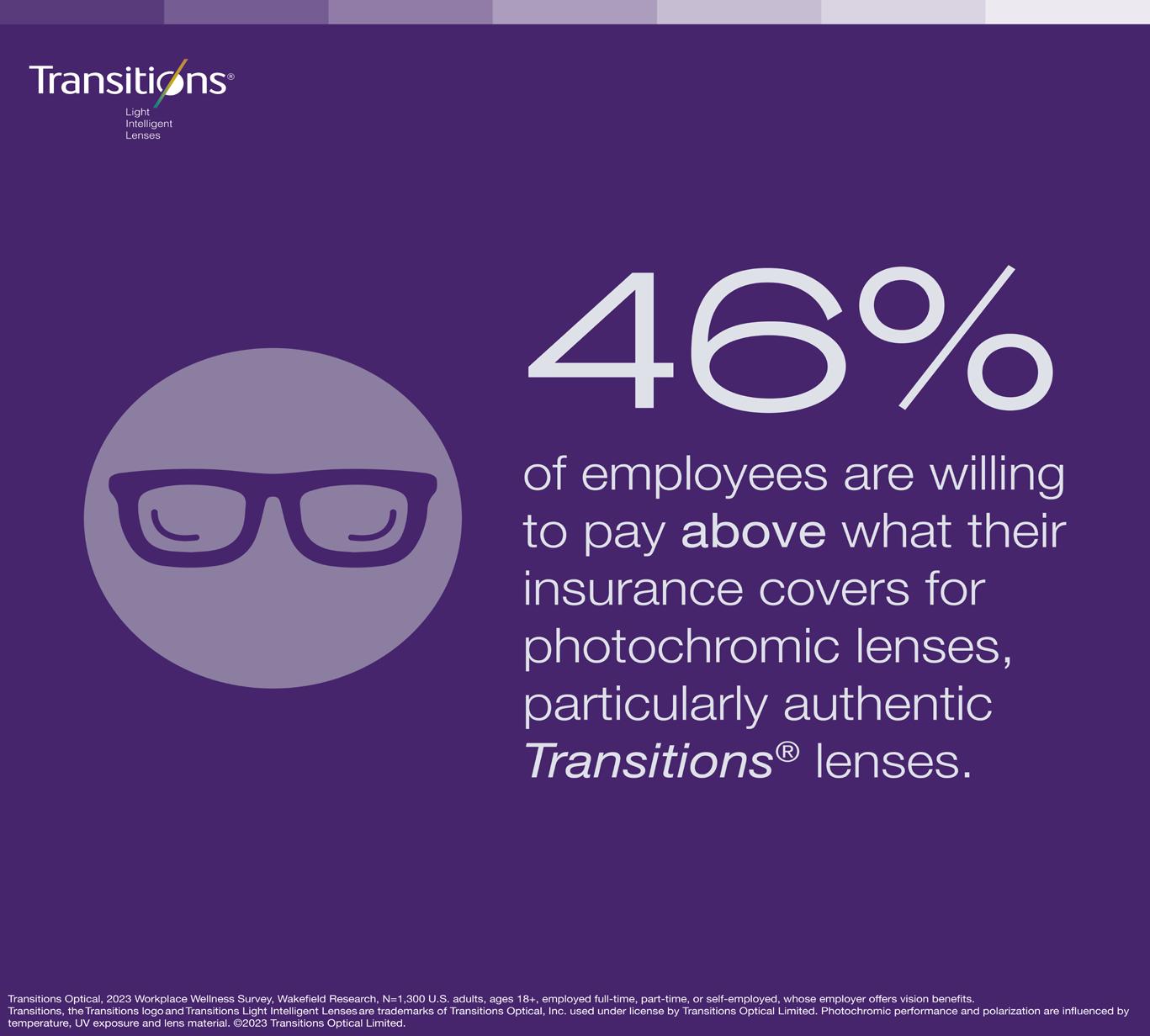
One easy and effective way to create workplaces where employees can truly thrive is by offering comprehensive vision benefits that include premium lens options. With healthier eyes, employees can experience increased productivity and overall wellness no matter where they work.As such, employees deserve the best vision care benefits an employer can offer, and light management is key.
How Premium Eyewear Options Can Support a Positive Employee Experience
Transitions Optical’s newly released Transitions® GEN S™ lens—available on all major vision care plans—is engineered to face the challenging light situations employees may experience in common working environments, delivering better vision quality faster, minimizing visual disturbances and accelerating vision recovery times.

(Vision quality improved in challenging light conditions, notably when moving from a bright to a darker environment (source B, Transitions® GEN STM compared to Transitions® Signature® GEN 8TM), in bright to very bright light situations (source A, Transitions ® GEN S TM compared to clear lenses) and in low light with peaky stray light (source A, Transitions ® GEN S TM compared to clear lenses)
Specifically, Transitions GEN S provides 39% faster vision recovery from intense bright light compared to clear lenses. Transitions GEN S also excels in adapting to changing light conditions such as going from a bright to a low-light environment, providing 40% faster vision recovery during fade back compared to the previous generation. (Subject-masked cross-over randomized controlled investigation performed in 2023 on 10 healthy pre-trained participants. This rapid adjustment means less waiting for eyes to adapt, and a more consistent visual experience for the wearer.
Companies that offer premium eyewear options like authentic Transitions® lenses as part of their employee benefits can contribute to the visual comfort of their workforce, which has been shown to increase productivity and overall wellness (1). Employers can also enhance the overall attractiveness of their benefits package, contributing to employee satisfaction and retention. In fact, 69% of employees say it is important or extremely important employers offer vision insurance as part of a comprehensive benefits package. (1) Additionally, according to the Pew Research Center, 43% of departing employees say benefits (or the lack of benefits) was one of the reasons they quit (3).
With 79% of employees indicating that protecting their eyes and their eye health is more important than ever, employers offering premium vision benefits that cover annual eye exams and eyewear options— that employees both want and need—can help catch the attention of employees.
As suggested by our research, employees want it all: enhanced vision whatever the light, protection, and style—so much so—that 95% of employees who wear eyeglasses and have vision benefits are willing to pay above what their insurance covers for premium lens benefits, including scratch-resistant lenses, anti-reflective or no glare coatings, photochromic lenses, UV blocking, and premium lens design including a sharper, wider field of view (4). Further, nearly half (46%) of employees are willing to pay above what their insurance covers for photochromic lenses, like Transitions® lenses (4).
However, eye health literacy has been identified as one of the major barriers to eye care among U.S. adults (5). This finding emphasizes an opportunity for brokers to work as strategic consultants to employers by helping human resources leaders become more educated on the value of premium vision benefits and effectively communicate the importance of dynamic eye care to employees. Demonstrating the impact of educating employees on premium lenses, 73% of employees say they are much or somewhat more likely to enroll in a vision plan that offers Transitions® lenses when armed with the knowledge of their protective benefits (4).
By offering premium vision benefits like the all-new Transitions GEN S lenses—which can adapt and help improve vision quality in all working environments more quickly than ever before—employers can actively transform the employee experience through increased employee productivity and overall health and wellness. You can learn more about Transitions GEN S lenses by visiting our website at www. transitions.com/en-us/products/transitions-gen-s/
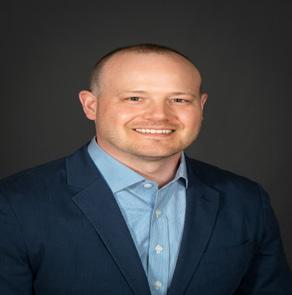
Jonathan Ormsby is a Senior Manager –U.S. Managed Care for Transitions Optical. Reach out to him at jormsby@transitions.com
https://www.transitions.com/en-us/products/transitions-gen-s/
Sources:
1. Ragan Communications, September 2023, https://www.ragan.com/white-papers/313518/
2. Gallup, June 2024, https://www.gallup.com/workplace/349484/state-of-the-global-workplace. aspx?
3. Pew Research Center, March 2022, https://www.pewresearch.org/short-reads/2022/03/09/ majority-of-workers-who-quit-a-job-in-2021-cite-low-pay-no-opportunities-for-advancement-feelingdisrespected/
4. Transitions, 2023 Workplace Wellness Survey, Wakefield Research.
5. Healio, May 2024, https://www.healio.com/news/optometry/20240508/top-barriers-toeye-care-among-americans-include-cost-accessibility-health-care-literacy#:~:text=Cost%2C%20 insurance%2C%20transport%20and%20accessibility,a%20systematic%20review%20in%20Cureus.
In April, the FTC issued a final rule largely banning non-competes nationwide. The groundbreaking ruling has the potential to shake up the job market. With millions potentially affected, what’s at stake for employers and employees?
Dive in to explore alternatives and unravel potential impacts. Will this ruling revolutionize the workplace or spark a legal battleground?
Non-compete agreements, commonly known as non-competes, were designed to safeguard businesses and have been a mainstay in workplaces nationwide for decades. They are a contractual arrangement in which one party, usually the employee, agrees to refrain from certain activities that could create competition against the other party. These activities may include disclosing proprietary information or trade secrets acquired during employment. Agreements also often include restrictions on working for a direct competitor for a defined period after leaving a role. While each state in the U.S. has its own laws regarding non-competes, understanding their purpose is essential. Prior to 2023, states like California, North Dakota, and Oklahoma had outright banned these agreements, and others had introduced measures to limit their enforceability for specific employee groups. However, the movement against non-competes gained significant momentum in 2023 with legislative efforts to restrict their reach increasing considerably.
By Misty Baker GROUP INSURANCE

The FTC ruling casts a wide net of restrictions on non-compete agreements, leaving no stone unturned in its reach, prohibiting the creation of new contracts and the enforcement of existing ones. It also extends to individuals’ obligations under such agreements, aiming to limit their influence on labor mobility.
However, there are exceptions to this prohibition. Senior executives who signed noncompete agreements before the ruling can keep them only if they meet specific criteria related to their seniority and compensation package. Senior executives who signed non-compete agreements
before the ruling can keep them only if they meet specific criteria related to their seniority and compensation package.
In addition to this provision, the FTC delineates specific circumstances where exemptions come into play. These exemptions cover a range of scenarios, including the sale of corporate entities, ongoing legal disputes that preceded the ruling, and geographic jurisdiction limitations. It also recognizes the complexities of international employment agreements, which require different considerations.
The exemption for the sale of corporate entities is particularly significant because it allows non-compete agreements to remain in effect after a change in ownership, provided that the new owner is engaged in the same line of business as the former owner. The exemption for ongoing legal disputes acknowledges that some non-compete agreements may have been signed before the ruling and are already the subject of litigation. Finally, the exemption for geographical jurisdiction limitations recognizes that some non-compete agreements may be valid in one state but not another.
Each exception adds a layer of complexity, acknowledging the nature of employment relationships. The ruling aims to strike a balance between protecting the interests of employers and promoting labor mobility, recognizing that there are circumstances where non-compete agreements may be necessary. Overall, the regulation embodies a robust and assertive structure that provides clear guidance on noncompete agreements and their exceptions.
Required Notice: The ruling mandates that employers provide unequivocal notice to employees who’s non-compete agreements fall under the rule’s purview and are consequently deemed unenforceable. This requirement aims to ensure transparency and inform affected individuals of the legal status of their agreements, empowering them with knowledge about their rights and obligations in light of the regulatory changes.
Impact on State Laws: Historically, noncompete clauses fell under the purview of state laws. However, the FTC’s ruling introduces a significant shift by asserting federal authority, albeit selectively, over certain aspects of these agreements. Nevertheless, the interplay between federal and state regulations remains intricate, with state laws retaining relevance depending on their specific provisions.
Legal Challenges and Next Steps: As the dust settles on the recent non-compete ruling, anticipation mounts for the legal challenges and subsequent steps that lie ahead.
At this point, immediate action in response to the ban is not required. The ruling has 120 days before it takes effect, and multiple challenges have already been filed, with additional challenges expected.
In recent years, the NLRB has also been very active in increasing scrutiny regarding unfair labor practices, such as requiring long notice periods and repayment of exorbitant training costs. The combined scrutiny of the NLRB and FTC means that it would be wise for employers to become familiar with the FTC ruling and what it does and does not impact. Reviewing current employment practices to ensure compliance with applicable state laws and the National Labor Relations Act is also essential.
The implementation of the FTC’s ruling represents a significant shift in regulatory oversight, signaling a new era. The final rule is extensive, covering a wide range of agreements that govern employer-employee relationships, going beyond traditional non-compete clauses. While awaiting further legal clarification, it’s clear it will have a far-reaching impact on many industries, influencing employer-employee relationships soon.
Once a district court decision is made, appeals will follow, and a Supreme Court stay decision is likely before the September 2024 effective date. Regardless of the final decision, the FTC has investigative authority and will continue to investigate the conduct of companies regarding non-compete agreements. There is likely to be increased scrutiny of non-competes during and arising from transactions. If the FTC ruling is enacted in its current form, breach of contract claims, and trade secret misappropriation claims are likely. Litigation between employees and employers is expected, and insurance policies like Directors & Officers Liability (D & O) and Employment Practices Liability would potentially be impacted, emphasizing the urgency of reviewing and updating these policies.
A wait-and-see approach that avoids making sweeping changes is best now. There will be a law change moving forward, which may result in greater regulation to confirm employers are complying with applicable state law, a change in non-compete guidelines at the state level, or, ultimately, an amended version of the current FTC ruling.


Misty Baker director of compliance and government affairs at BenefitMall, is an Affordable Care Act compliance and agent advocate, specializing in ACA, ERISA, FMLA, COBRA, and legislative advocacy for over 20 years. She was a registered lobbyist in Texas for four years and is a strategic leader focused on compliance, agent knowledge, legislative advocacy, and ultimate client understanding of how to be successful in the changing world of compliance. Her passions include agent education, insurance advocacy inside and outside of the Capitol, and compliance.
Sources:
• FTC Announces Rule Banning Noncompetes, Federal Trade Commission, April 23, 2024.
Potential Impacts of FTC’s Near-Blanket Ban on Noncompetes, Insurance Journal, May 2, 2024.
• Lawsuits Filed Challenging the FTC’s Final Rule Banning Non-Competes, The National Law Review, April 30, 2024.

By: Phil Calhoun and David Ethington
Cal Broker salutes health insurance experts as they play a crucial role in helping their clients navigate the complex landscape of health insurance policies, coverage options, accessing care, and managing healthcare costs. For new brokers in this industry the information below includes “items” to strive to perform. We follow this with some Smart Planning Tips to protect, grow, and someday sell your book of business which is often a misunderstood value you create while building your book of business.
For all health insurance professionals the roles listed below are achieved with hard work, collaboration with others, and a commitment to performance.
As you continue to provide excellent service to your clients, grow your book of business, and develop as a subject matter expert and trusted advisor, how carriers deal with your commissions is often assumed to be in your best interest.
1.Education and Guidance:
Health insurance experts educate clients about all the health insurance plans available, including HMOs, PPOs, and high-deductible health plans. They explain the benefits, limitations, and costs associated with each option.
2.Assessment of Needs:
They assess clients’ healthcare needs based on factors such as family size, medical history, current health status, and budget constraints. This helps them recommend suitable insurance plans that align with the clients’ specific requirements.
3.Plan Comparison:
Health insurance experts compare various insurance plans from different providers. They analyze factors like premiums, deductibles, co-payments, out-of-pocket maximums, and coverage for prescription drugs, preventive care, and specialist visits.
4.Customized Recommendations:
Based on the assessment of clients’ needs and plan comparisons, health insurance experts provide personalized recommendations. They explain the advantages and disadvantages of each option and help clients make informed decisions.
5.Enrollment Assistance:
They assist clients with the enrollment process for selected health insurance plans. This may involve filling out application forms, submitting necessary documentation, and ensuring that enrollment deadlines are met.
“Health insurance experts play a vital role in empowering clients to make informed decisions about their healthcare coverage, ensuring they have access to the healthcare services they need while managing costs effectively.”
Overall, the list provides a view into the work health insurance experts perform and how they play a vital role in empowering their clients to make informed decisions about their healthcare coverage and work to ensure they have access to the healthcare services they need while managing costs effectively.
As a reward for health insurance professionals who successfully do the work outlined above, the insurance industry compensates for this success with commissions. Residual commissions are earned when doing the work consistently and applying the professional and timely advice clients need.
your clients enjoy your commitment to provide them with the right coverage within their budget.
When considering protecting commissions and looking at how you will “leave” the business in the future, many health insurance professionals look to exit through a professional planning process which is designed to complete a successful sale to a Buyer. Our work with brokers provides many stories of how they go through this exit process with doubts, fears, confusion, and financial questions.
Just like successful health insurance professionals work with trusted advisors to provide the plans and services their clients need, active brokers also need trusted advisors to help with their commission protection planning. The ideal advisor can assist with all the exit planning processes needed for a successful exit. An advisor who: provides the necessary legal sales agreement, uses a proven and fair valuation method, develops a payout arrangement backed with sound accounting practices, uses a process to successfully transfer commissions, and then consistently pay the agreed on and accurate amounts throughout the payout period. Anything short of these professional planning components and a proven comprehensive exit process will leave the Seller, you, in a less than desirable position.
Our commission planning clients share many stories of how they go through this exit process with doubts, fears, confusion, and financial questions.
If you need to speak with a planning professional to get answers to your exit planning questions, reach out to us. We invite you to get on a call any time to clarify what you have heard about commissions. 75% of the calls we receive are based on misinformation. Call and learn from us as subject matter experts on health insurance commissions. Our goal is to help and, in this process, we cover growing, protecting, and selling commissions facts. We commonly help sort through what brokers hear from insurance carriers and often industry colleagues as well. As subject matter experts on commission planning, we can clarify what you have heard. We stay up to date annually with all the carrier forms, rules, and regulations when it comes to health insurance commissions. As subject matter experts we are 100% committed to commission planning.

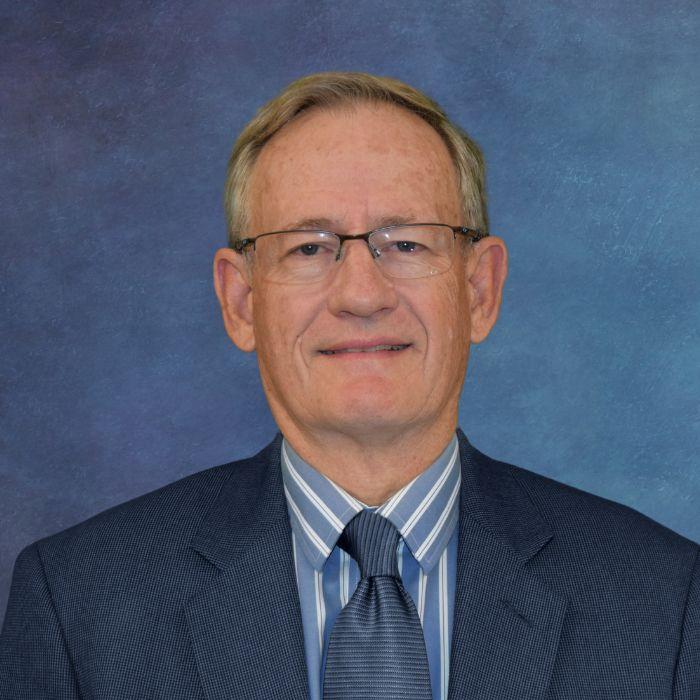

Phil Calhoun: phil@commission.solutions
David Ethington: david@commission.solutions Click here to schedule time to learn more

By Bill Cates, CSP, CPAE

I’ve written about the topic of differentiation many times and I suppose I will continue to do so until I ride my bicycle (or kayak or golf cart) off into the sunset.
In my book, Radical Relevance, I provide 17 “Rules of Radical Relevance.” Rule #5 is Only Differences that Matter, Matter.
So, first and foremost, anything you use to distinguish yourself must be relevant to your prospect. Otherwise, you might as well be invisible.
I often coach financial professionals to have more than one differentiator. This increases the chances that at least one of those differentiators will attract attention and compel the prospect to pay attention. Plus, while one differentiator may not be super compelling to your prospects and clients, though several differentiators working together can be.
Before I enumerate categories for potential differentiation, here are the five most common attributes I see advisors using in their attempt to differentiate themselves with prospective clients and why they aren’t really differentiators.
“We Care About Our Clients”
Well I should hope so! I’ve never seen an advisor state otherwise. If everyone is saying it or could say it, is it really a differentiator? Now, IF you have some anecdotes and/or case studies that show what this really looks like … if you can paint the picture in words or with actual pictures how your caring goes above and beyond the norm… then perhaps you can make it one of your differentiators.
“We Get to Know Our Clients’ Goals and Dreams”
This, too, should be a given. Most every financial advisor I’ve met talks about this, and they should (though for some, this is merely lip service). What CAN set you apart from most others is if you keep referring to these goals and dreams with your clients. Remember and support them with the bucket list or however they think about their future. Support them in any way appropriate. Become your clients’ dream maker!
“We Offer Advice Tailored to Our Clients”
One could make the case that “tailored advice” is a relative statement. There is no doubt that some advisors bring a cookie-cutter approach to their process, while many other advisors work quite diligently to offer highly customized solutions. The key to turning this look-alike attribute into a differentiator is to share specific examples, anecdotes, and case studies. Bring this to life and it can become a strong differentiator.
“We Educate Our Clients”
I’ve observed that how advisors educate their clients varies greatly. Some advisors do the bare minimum, and some go to great lengths to educate their clients in many ways. Some advisors may explain things very well in meetings. Others produce a blog and/or newsletter. And others host regular educational events – not prospective events, but events for their current clients and guests.
“We Provide Great Client Service”
Providing timely and accurate service is the price of admission for any business. Once again, if you can bring this attribute to life with examples and testimonials, you will make this feature of your company stand out. A differentiator? Maybe not. Important? Certainly!
*Please Note – I’m not saying you shouldn’t communicate these 5 attributes to your prospects (in meetings, on your website, etc.). You should. But unless you do any of these things in a demonstrably superior manner, they are not strong differentiators.
Here are categories of differentiators for you to consider using (as long as they are true):
1.
Specialize in business owners within a target industry such as contracting, franchising, retail, and hospitality. The list is practically endless.
2.
Specialize in employees within medium to large companies.
3.
Specialize within an affinity group (women, philanthropists, families with children with special needs, and athletes.
4.
Specialize in university employees – both faculty and administration.
5.
Specialize in a narrow group of professionals, such as attorneys, physicians, veterinarians, and architects.
6.
Provide a team of experts within your firm.
7.
Offer a truly superior discovery, planning, or onboarding process.
8.
Specialize in serving clients of a certain financial demographic – income, assets, accumulators, pre-retired, and/or retired.
9.
Emphasize your special credentials and/ or certifications and what they mean to your clients (how they benefit)
10.
Specialize in a specific product and/or solution for specific challenges and opportunities.
11.
Offer access to information truly not available elsewhere. If you’re an RIA, this can be your unique perspective toward financial planning, investments, and insurance.
12.
Provide a level of serv ice and client contact that is truly distinctive from others.
13.
Focus on creating a boutique or family office client experience.
14.
Emphasize your culture and values. [See the book: The New Gold Standard: 5 Leadership Principles for Creating a Legendary Customer Experience Courtesy of the Ritz-Carlton Hotel Company]
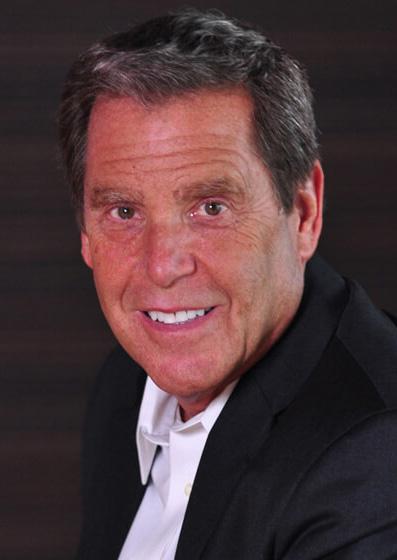
Bill Cates,CSP, CPAE, is the author of Get More Referrals Now, Beyond Referrals, and Radical Relevance. Bill’s newest book, The Language of Referrals, has just been released and is available at Amazon in paperback, Kindle, and Audible. Bill is a highly soughtafter coach, consultant, international speaker, and virtual presenter.
CalBroker Readers can get free (and valuable) tools here: www.ReferralCoach.com/resources
Bill can be reached directly at: BillCates@ReferralCoach.com

By Calbroker & Renée Caldwell
We asked Renée to share with us how she collaborates with clients and referrals from health insurance professionals who have clients that have a need to review their options for LTC insurance or look at an in-force policy.
Renée, can you walk us through an outline of the process you take clients through?
Renée: Step one is focused on education. I prefer to first help clients become knowledgeable of the LTC products available. From my experience, Traditional and Hybrid Life/LTC are the ideal products if the client’s health and budget are within an affordable window. So, we start here and explain the policy coverages and answer questions, so clients receive the necessary education.
Next, we explain how Annuity/LTC linked products work. Since in some cases these policies can be a fit when a more health-discommended client needs coverage and when the client can pay a lump sum, or one time, premium. The Annuity/LTC products also work with 1035 Exchanges from Qualified and Non-Qualified annuities which gives clients options to consider the cost of the policy.
Short term care for health or budget concerns?
Renée: The information gathering process is important and we like to reinforce to health brokers and their clients that with more information we can help them get through underwriting and reach the last step, policy delivery success, with a clear understanding of the client’s health. With the client’s health information, we then send in a quote request anonymously to the selected insurance companies to see if they will consider the client for coverage, and at what ‘rating’ they would issue.
We also take the time to learn about the client’s finances in round numbers to understand how they can afford coverage and given their budget, we have an idea as to what is the most suitable product(s) for their financial situation.
“ We always like to meet with the referring broker and their client to build some of the coverage options that fit based on what we know about their health rating and finances.”
This step is often a Zoom meeting as we spend time screen sharing to build policy coverage options together. I enjoy this interactive step as the client can see the details of how the coverage is built, they can adjust various coverage details with me on the fly, and this allows we can narrow down their priorities of coverage and budget during this conversation. Then the quotes they are most interested in considering are printed off and sent to the broker and their client. I always include a Cost of Care guide so they understand how their coverage will support their aging today and into the future and how much of the Cost of Care risk they are covering with each of the LTC products we quote.
After some time to consider which of the quoted LTC plans have the coverage and premium balance, it is time to meet again and help move to a decision. Armed with an indication from the anonymous quote request and a decision on the type of coverage desired, we complete the appropriate carrier application. This step usually involves screen sharing as we take an e-application. Then once submitted, the underwriting process will officially begin.
I coach the client about the typical steps in the underwriting process. It is important clients know they are responsible for completing a phone health interview with the carrier. Once complete we just wait for the carrier’s decision. Depending upon the insurance product and carrier this may be the only underwriting that happens. However, if required or needed, a carrier has the right to pull the client’s full medical records. When this action is pursued, this can be the longest part of the process. We often collaborate with clients to assist with acquiring the medical records from their doctor.
Once the client interview and the medical records are reviewed by the carrier, an underwriting decision is announced and hopefully there is an offer of insurance! Sometimes people get an offer, but it is not at the rating they applied for as the underwriter found information in the medical records that may have knocked them down to a lesser rating meaning higher premium than quoted. We then focus on what this means as far as the cost for the policy coverage. As the premium increases make the policy more expensive, it is common to either accept the offer, or adjust coverage down to stay affordable. In my experience many clients are happy that they can still get LTC insurance, and they know the value of the coverage. Sometimes we need to ‘shop’ the industry and consider a different LTC product. This is the beauty of being a broker!
Once an offer of coverage is received, we confirm with the insurance company that the policy is accepted, and they send the policy to print, or it is sent via email. Depending on the technology the carrier has available, or the desire to have a policy in print or electronically sent. Once the client accepts the policy and pays the premium their coverage is secured!
All LTC policies are Guaranteed Renewable, which means if the client pays their premium then they are guaranteed coverage when they need it.
In some instances, we have combined two LTC insurance policies to get the coverage our client needs when the policy they are approved does not meet their coverage goals. As any advisor understands, it often is a team effort to provide the solutions a client needs. The collective experience of my team and my ability to access this expertise helps clients get coverage that many may not know exists or possess the knowledge to build coverage solutions through multiple carriers and policies.
In the event you have a client who could benefit from a personal and confidential review of their questions about Long Term Care costs and insurance options to address these costs, please go to: www.buddyins.com/program/calbroker/
At Integrity Advisors, our collaborative partnership with Renée Caldwell has worked well as we placed LTCi policies for ourselves and clients with Renée. Renée works with other health insurance only brokers to help their clients with LTCi.
Each person’s needs for LTCi varies and the underwriting process can be a challenge. Renée is a subject matter expert in LTCi and with her knowledge of the insurance carriers and coverages she is able to get coverage for what people need.
She also works in the state of Washington where a state LTCi program began a couple years ago, so in the event California has a similar program, Renée is monitoring California and will be able to help Employers and their employees.
If you want to collaborate Renée is a great option and you can stay involved in the process with your client referral.
We enjoy the process of working with life and health insurance professionals and their clients. Please reach out with your client needs for LTCi.
To learn more about LTC planning and how you can find peace of mind for your family and clients, please connect BuddyIns.
California Broker is pleased to have a collaborative relationship with Buddy Insurance, a leading long-term care insurance education, marketing and technology company. CEO Marc Glickman and his specialists will collaborate with health and life insurance professionals to help design LTCi options. Learn more about LTCi and refer clients — or learn how to write your own LTCi policies using Marc’s system.
CONNECT to Buddy Insurance LTCi PORTAL HERE: www.buddyins.com/calbroker

Renee’s commitment to Long Term Care is motivated by having watched her parents care for her grandparents. Due to lack of planning, her parents had to make important and tough decisions for their own parents at the end of their lives. Renee’s desire to help people and families be prepared for that challenging time in their lives is evident in her commitment to guide families to investigate their options and sensibly manage their long-term care risks.
Renee’s Caldwell is a member of the Long-Term Care Producers Group, a nationwide group specializing in Long-Term Care Products. She also works nationally within a community of LTC experts helping clients, and partners with other insurance specialists to be the subject matter experts. Renee has worked in the industry for 15+ years and is licensed in more than 40 states so she can assist clients and handle referrals with the client’s interest and needs in mind.
To learn more about LTC planning and how you can find peace of mind for your family and clients, please visit:
www.buddyins.com/program/calbroker/


By Eric Trost
he old saying “the riches are in the niches” has never been truer when it comes to proper advisement in the employee benefits space. In a world that is so cluttered with advisors and brokers all claiming to have “the best solutions” and “they are the best for all clients”, we have found that is not true for all industries. One industry that we can focus on is the government contracting community. These are private employers that do work for the federal government across all agencies and all types of work. Often, benefits brokers don’t understand that this type of group requires a special focus and attention paid to them. Let’s dive into this further.
• These companies perform services other than IT, administration, or new construction.
• They must pay a per-hour worked rate used by the employer to pay for qualified bona fide fringe benefits ON TOP OF AND OUTSIDE OF THE HOURLY WAGE FOR THE JOB THEY ARE DOING.
The following qualify as bona fide fringe benefits:
• Health
• Dental
• Life
• Disability
• Retirement
• Some indemnity programs
• Cash In Lieu of benefits (CIL)
• These companies provide services typically over longer-term contracts and can be a more predictable risk for more favorable underwriting (should you understand what you are working with).
• There is a tracking/reporting that is needed for the DOL and on demand.
• These companies perform construction services (bridges, roads, buildings, etc.).
• They are required to pay a specific fringe rate based on the job being done by the area the work is being done in.
• Jobs can be short or long in duration, which can create an underwriting issue if you don’t understand these groups. (Again, you need to know what you are doing).
• There is a tracking/reporting that is needed for the DOL and on demand
• Do not have a specific requirement per hour for benefits BUT there is a real need to understand the group and contracts.
• This is more than just getting an underwriter to get you a rate.
Now that we have covered GOV CON Basics, your head is probably spinning, and you are saying “I don’t write those groups and I don’t want to.”
•
Well, I am willing to bet you have a GovCon in your book of business and you don’t know it, or you have had a client ask you about one of the terms from the above in your career. Your response was probably a GOOGLE search, finding a few names, running a census with the names you found, and you sold a package and told your client you are an expert in govCon. It’s okay. We have heard it all before over the past 20 years and we know this happens all the time.
1) If you want to really help your clients and be in the league of a true advisor that does what is right for your clients, then here is the best path.
2) You CANNOT simply get a self-funded plan that promises 20-30% savings.
3) You do NOT have to go to a name you found on GOOGLE and only sell their plans.
4) You CAN get the proper insight and integrated platforms without sacrificing your relationship or your position with the client.
5) You MUST adhere to the type of contract requirements (SCA, DBA, PW, etc) when advising a GovCon because there are reporting and tracking requirements the contractor must provide.
You CAN obtain data specific to GovCon and it WILL help you provide the best solution for your clients.
Okay, we are done with the scary part of this article. Now onto the ways for YOU to be the advisor of choice, win new GovCon clients, help them win more awards and retain more from those awards, and build a book of business that can literally be bullet proof.
The first thing you need to do is connect with companies that understand GovCon. There are several companies that have been working with brokers and GovCon’s for over 30 years. The issue is those companies will only sell you what they sell. There are only a few that will help you truly build what you need, have the technical resources needed, and will deliver at the financial end for the govcon, so they win year over year. You wonder what they mean? Let me explain.
GvoCon’s are very intricate, not only from what we highlighted above, but rather because the underwriting and type of benefits you recommend, can literally make or break the financial health of a GovCon. Here is why I say this. A government contractor has bid on each contract they want to work on. That requires them to “build up” their rate structure and one of the most impactful aspects to their rate structure is (total shocker coming up), EMPLOYEE BENEFITS. The benefits rates they use to build up these rates also must be good without much increase or fluctuation up (if the rates go do, they will love you forever) because they simply don’t have the ability to absorb increases without taking from somewhere else in the rate structure. Since benefits are the recruitment and retention strategy for all companies, benefits HAVE TO BE involved. Here is an example:
• You have a 50-person group that is an SCA contractor and they have a mandatory per hour fringe rate (there are 2 possible) that have to be provided to the employee for each hour worked.
• Let’s assume all 50 are full-time benefits eligible.
• You recommend a level funded solution with all the bells and whistles, and you are DPC champion with the best transparent PBM solution out there.
• You show a 20% savings from the legacy BUCA PPO they have had in place, and you promised them this is the best solution, and the group says they “know” they will double within the plan year
• Without knowing the contract values and the true nature of the contracts they have, what would happen to your recommendation if the group lost a 10-man contract during the plan year? Yes, you are screwed and so are the rates of the group at renewal.
• Did you also understand that you needed a compliance partner and an INDEPENDENT TRUST MANAGER AND FIDUCIARY to manage those Health and Welfare for the self-funded plan? We know you didn’t know that and that’s why we are here. We have you covered and now you know you need to have these resources in place, so your recommendation is right from the jump and the return is what you promised/sold the group.
• There are also very few solutions that can provide multiyear guarantees for those rates, but now we are getting into 301 level stuff.
• You can also just stay with your BUCA PPO solution fully insured and you don’t need to worry about the third-party trust and fiduciary, but you still have the reporting requirements AND you cannot dare turn around a 20% increase to your client.
So, choose wisely and reach out to the resources before getting into the “yes, I do work with GovCon’s and I can save you 20% versus what your other broker provides you” mode. We are providing this article because we have provided these solutions across the country and helped many brokers and clients in the GovCon space win.

Eric Trost is a benefits consultant at NCA-Consulting and leverages his expertise in employee benefits to provide customized and costeffective solutions for brokers/consultants engage and help employers across various industries. NCA is an independent consulting firm that is dedicated to the principles of service, integrity and professionalism while providing our valued partner clients, brokers/consultants, and third-party administrators the highest quality of service with the goal of exceeding expectations.
Our team has over 100 years of combined experience in areas such PPO network evaluation and other programs that can save self-funded employer groups money without cost shifting to their employees. Our team is uniquely positioned to help control health care costs, communicate plan features and ensure legislative and regulatory compliance. Engage with us and create your path to growth with strategies that work from plan analysis, custom provider networks, our partner network to responsibility, ensuring compliance and that your plan runs efficiently. NCA is positioned to provide the customization needed to win more business.
949-922-3920
eric@nca-consulting.com
www.benefitsoptionins.live/home-page
By Maggie Stedt, C.S.A, LPRT, Medicare Chair
Senior Summit is almost here! Are you ready to learn about all the changes coming in Medicare sales and marketing? Do you want to learn about product offerings and the changes for 2025? Are you ready to expand your business by exploring new ideas and meeting our outstanding speakers, hearing some in-depth panel discussions and to share ideas with your peers? Plus, are you up to some golfing, great times in the casino, relaxing by the pool or dining in various venues? Then the 13th Annual Senior Summit is where you want to be! This event, held at Pechanga Resort Casino in Temecula in Riverside County, offers something for all those in the Medicare, group, individual and ancillary markets. Over 65 exhibitors are looking forward to sharing their products, programs, tools and insight with you!
We have three days packed with presentations, CE classes, product and marketing information for 2025 and fun! We have two great keynote speakers presenting on Tuesday and Wednesday, Michael Fahey III, District Manager for Colonial Life and Ret. Major General USMC, and Stan Morrison, Hall of Fame basketball coach and motivational speaker They will share insights, ideas and some tricks on becoming better and more successful agents and managers. We are also delighted that our new National Association of Benefits and Insurance Professionals (NABIP) CEO, Jessica Brooks-Woods and Rosamaria Marrujo, President of our California Agents and Health Insurance Professionals (CAHIP) will also be joining us. We kick off the event on Monday, August 19th with golfing at Pechanga’s Journey Golf course with a shot gun start at 2 pm. Tuesday starts at 9 am with our opening welcomes and with our Gold Ribbon Sponsor, SCAN Health Plan and our Ribbon partners, Alignment, Molina, Humana, Anthem Blue Cross and AGA. We will dive deep into the 2025 Marketing Rules for 2025 and in the afternoon, you will have several choices for CE classes and other presentations. Among the topics are upping your game using social media, understanding your MediCal opportunities, addressing cyber security, with more to come. On Wednesday, we will take a deep dive into legislation and regulations happening both in Washington DC and Sacramento affecting our business and our clients. The “Heard on the Street” panel including our association Presidents, Paul
Roberts, CAHIP VP of Legislation, Austin Fitch, VP of Operations and Nick Uehlecke, Todd Strategy Group, will be open to your questions and concerns.
In later sessions there will be a panel discussion addressing prescription drug plan and program changes lead by Bill Hepsher of the Canadian MedStore. Sponsored by AGA, a carrier panel will then address marketing and sales issues.
We will finish the day with additional CEs and presentations, including Medicare Trends, Medicare and the Group Broker and more to come! Thursday is all about our carriers and their products and services for 2025. They can’t wait to share this information with you. It is time to sign up to make sure you take advantage of our early bird pricing and to secure your hotel room by July 19th!
To register, simply visit our website: theseniorsummit.net
See you there!

MAGGIE STEDT C.S.A, LPRT, is an independent contractor/licensed agent and consultant. She is a certified senior advisor and lifetime member of NAHU’s Leading Producers Roundtable at the Soaring Eagle Level. She has over 40 years of experience in essential areas of the insurance industry including sales and sales management, product development and product management. A dedicated leader, Maggie currently serves on the NAHU Medicare Advisory Committee. Founder of the annual Senior Medicare Summit, attendance grew from 200 in 2010 to close to 1,000 attendees in 2022. She served as past president of CAHIP; NAHU Region 8 Membership Chair 2014 – 2018 and past president of OCAHU, serving two terms.
maggiestedt@gmail.com
We are here to support the GovCon broker community whether you ’ ve won your first contract, or your fifteenth, NCA Consulting has the knowledge and technology resources to support your team We help create efficiencies and profitabiltity for SCA, DBA and ATSA.
Aligning the right solutions to match your objectives and provide the best outcomes for your clients!
Custom benefits planning using proprietary tools built for the GovCon industry, we ensure your clients are able to maximize the dollars available for their employees.
Through our Government partners you can gain access to proprietary software that ensures your clients remain DOL compliant with end-to-end functionality.
We can help you align your clients goals and their contracts in order to optimize profitability and deliver on their employees needs.

By Genna Armanini GROUP HEALTH
While recently attending a broker event in Los Angeles, several brokers we spoke to thought CalCPA Health ONLY wrote CPA firms. Financial services firms are also in play. In recent years, the California Society of Certified Public Accountants (CalCPA) has expanded to include a broader swatch of firms, including financial professionals.
So, what exactly is a financial services firm? Generally, think of businesses that help with or manage other people’s/businesses money, such as: wealth management, advisors, financial institutions, fiduciaries, loan brokers, retirement, tax, leasing, etc. This is a good opportunity for health insurance brokers because all their existing (business) customers have CPA and financial services firms they can easily prospect to.
If you haven’t worked with CalCPA Health before, now is the time. We are a trusted carrier with long-standing relationships, (70% of groups have been insured for over 10 years). Here are some reasons to write some business with us:
• Largest and well-known provider networks: CalCPA Health rents Anthem’s Prudent Buyer - Delta Dental – Vision Service Plan (VSP) networks
• Large selection of HSAs – Offering the most HSA plans in CA compared to other carriers (CPAs and financial professionals like HSA plans – they understand the tax benefits)
• Fully integrated HSA administration – making it easy for firm admins
• Long history of stable premiums – 3.4% average rate increase over the past 9 years
• Low participation for Kaiser stand-along
• Level 7% commission (first & renewal) for small group (2-50 enrolled)
• Complementary COBRA administration
• Owners-only firms are eligible
• Owner and W-2 spouse can be written as a small group
• Rates are based on the employee’s ZIP code – not the firm’s home office
CalCPA Health was created by the California Society of Certified Public Accountants in 1959 so their members have access to quality healthcare and benefit plans. If you have written cases with us in the past or if you have never heard of us, we ask that you look at what we have to offer you and your clients. This is a sure way to increase your book of business.
CalCPA Health – Health plans for CPAs and Financial Service Firms since 1959
To find out more about what CalCPA Health has to offer your clients, please visit us at

Armanini is the Marketing Director of CalCPA Health, a California domiciled carrier providing health plans to CPA and financial services firms. Genna has worked at CalCPA Health for over 23 years, growing brand awareness, helping maintain high retention, and enabling subscribers to become strong advocates for their health and well-being.


By Cal Broker
Scott G. Halversen was the VP of California Broker Magazine for over twenty years. When he noticed a lump slightly over a year after retiring, he went to his doctor who diagnosed the lump as cancer. Lymphoma he learned is often successfully treated. With tumors all over his body his cancer was serious and was at stage four. His doctor told him he would be in the hospital for four weeks. Then after the successful Chemo treatments another tumor was discovered. Scott learned he needed to receive treatment for another tumor, this time the tumor was in his brain.
Regarding the hospital treatment Scott reflected on the time we would spend in the hospital with no visitors due to Covid, “So how could I best use my time? I decided to write letters to all my kids and grandkids telling them how much I loved them and why they were special to me. My next project was to start writing my life story. Then I decided to write a ‘fun’ cancer book that might bring some smiles and useful tips to other cancer patients.
“I had stage 4 lymphoma with no symptoms living in a fool’s paradise. You must constantly check your body for bumps both on the surface and just below. It can mean life or death. Set your exam the minute a lump or bump is noticed.”
Heartfelt and deeply personal, Halversen decided to share his cancer treatment story in the hope of connecting with readers facing their own cancer diagnosis to help them understand they are not alone in their fight.
The book, “Suddenly My Zodiac Sign Changed from Gemini to Cancer” is a captivating account of Scott’s journey with cancer. Scott’s positive attitude, offbeat sense of humor, and loved ones by his side combined to help him recover. Readers enjoy the humorous cartoons, nitty-gritty hospital tips for coping with chemo, and ideas for quickly getting back on your feet at home.
“I spent a month in the hospital recuperating from a harsh chemo treatment which nuked my immune system and wiped me out. No visitors so my time became very precious. My fear was the real chance my brain could scramble if the chemo didn’t knock out my tumor.”
Scott’s tips for patients stuck in the hospital is great advice to deal with the many nurses, therapists, and MDs, and outlines a success guide for staying positive and helping with the hospital stay including the many tests and treatments, and also managing the basics of navigating the human body’s needs.
Scott managed to get through his ordeal with his positive attitude, offbeat sense of humor, and the loved ones by his side at every step of the way combined to help him get through many days in the hospital recovering from Chemo. The treatment program for my stage 4 lymphoma cancer seemed to have gone very well. I felt great. We were walking three miles a day when I wasn’t hooked up to an IV full of chemo drugs. I have never had nausea with any of the chemo infusions, but a lot of people can’t say that. They have come a long way in mitigating the effects of Chemo drugs.
It seemed like we were out of the dark--Then another medical issue!
“I couldn’t get the words to come out right, and Peggy couldn’t understand anything I was saying. It was clear something was very wrong. The next day I got scans and an MRI at the emergency room. A tumor about the size of a quarter showed up on my anterior brain lobe. My oncologist arranged to transfer me to the cancer center.” More Chemo and further treatment and fortunately Scott completed his treatment and today he is in full remission.
If I can be helpful to just one person facing chemo challenges, I feel this hospital work project of mine will be well worth it. I’ve put together a mixed bag of suggested activities, attitudes, and nitty-gritty hospital procedures to help a person get through chemo.
At the hospital, they did extensive testing, including spinal taps.
Our goal in life is to become more like the Savior in the end.
He willingly endured all the grief, pain, anguish, and loneliness this mortal life could throw at him because of his love for us. Why should we receive a get-out-oftrials free card? We really do need them. Sometimes we get a miracle. Sometimes we don’t. I wanted to learn all I could from the Chemo I would be going through no matter what happened. I was committed to being a better person than I was going into it.
“Learning you have a brain tumor sends shock waves through your mind,” writes Halversen. “Your continued existence is in question. You know the odds are against you”
“The typical hospital today is a regular United Nations. I have had people working with me from Ethiopia, Palestine, Armenia, Nigeria, Cuba, Indonesia, India, the Philippines—and the list goes on. To me, it’s fascinating to learn their stories.”
“I would typically ask them where they were from originally. I would inquire about their families. As we got to know each other, I would look for common ground in sports, movies, hobbies, work, or music. I would share jokes or music. I would ask what their parents did. I would ask how they got into nursing or whatever they were doing.”
Scott’s great rule of life: If you take an interest in someone, they will take a special interest in you.
I am here today because of an outstanding oncologist, her physician assistant, and a broad spectrum of medical personnel including nurses who rendered concerned care on my behalf.
My experience with California Broker Magazine and thoughts about health insurance professionals are very positive. I really loved working on the magazine covers most. Also meeting many of the authors and brokers at conferences. After my traveling my cancer treatment path through the health care system, I have a greater appreciation for the role of a health insurance professional who can help explain the coverages and access to care.
Readers can purchase “Suddenly My Zodiac Sign Changed from Gemini to Cancer” at bookstores everywhere, or online at the Apple iTunes store, Amazon or Barnes and Noble.
www.covenantbooks.com/ books/?book=suddenly-my-zodiac-sign-changed-from-gemini-to-cancer

Scott earned a bachelor’s and master’s degree from Brigham Young University and has worked in advertising and marketing for forty-three years.
After graduating from Brigham Young University, author Scott worked at an ad agency in Utah and secured a position in the advertising department of Occidental Life Insurance Company as advertising director. Scott then joined “California Broker Magazine” as the marketing vice president, retiring after thirty years. The author and his wife, Peggy, have four children and nine grandchildren.




Covered California coveredca.com/forsmallbusiness 844-332-8384
Commission Solutions commission.solutions Phil Calhoun Phil@commission.solutions 714-664-0311
Pinnacle Claims Management pinnacletpa.com
Summit 2024 theseniorsummit.net
Benefits Options Insurance Agency eric@benefitsoptionsins.com benefitsoptionins.live/home-page 949-922-3920
Medicare on the LaLa Land Stage-The Sequel cahip-la.org/meetinginfo.php 38 Petersen International Underwriters piu.org piu@piu.org 800-345-8816

9th Annual Medicare Summit Wednesday, August 14, 2024 ★ The Odyssey ★ Los Angeles, CA
8 AM REGISTRATION, BREAKFAST, NETWORKING
9 AM LEGISLATIVE AND COMPLIANCE UPDATE ★ FEATURING CHALEN JACKSON - CE PENDING
10:15 AM MEDITATION WITH NAAMA O. POZNIAK
10:20 AM MEDICARE: MENTAL HEALTH MATTERS ★ FEATURING DEDE KENNEDY - CE PENDING
11:30 AM S.O.S. - SCALING, OPERATIONS, SUCCESSION ★ FEATURING TIM KANTER ON SCALING, ELLIOTT MARTIN ON OPERATIONS AND PAUL DAVIS ON SUCCESSION
12:15 PM LUNCH WITH EXHIBITORS
1:45 PM GENERATIONAL COMMUNICATION: FROM GEN Z TO THE BOOMER MINDSET ★ KEYNOTE SPEAKER: LEE BROEKMAN
2:15 PM GETTING COMFORTABLE WITH AI ★ FEATURING ELKA SOUSSANA









